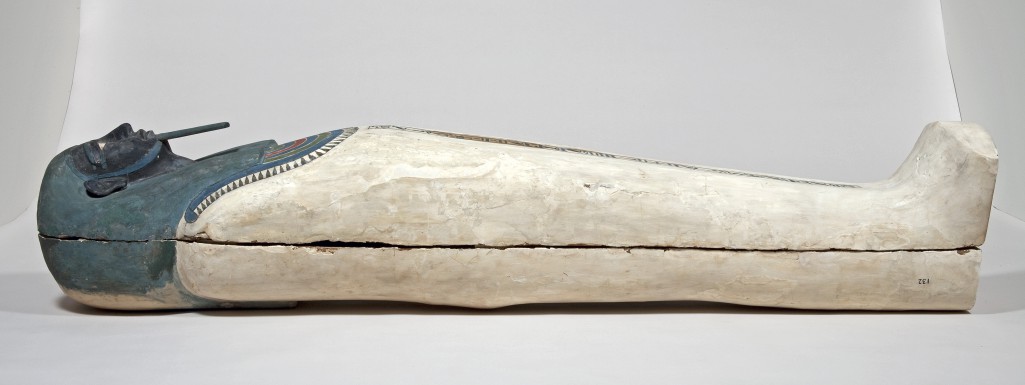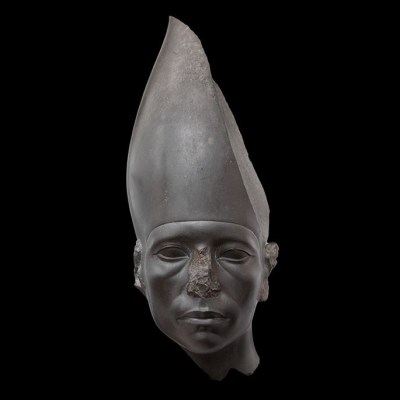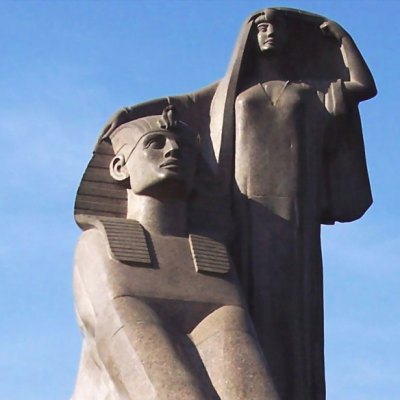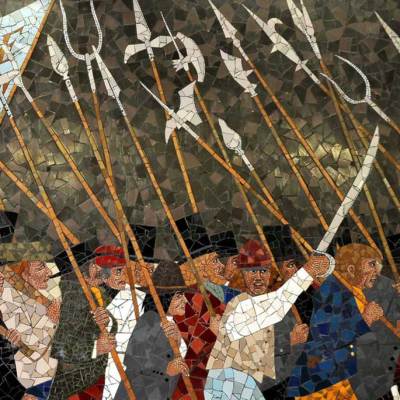Often, exhibitions of ancient Egyptian artefacts divide their galleries into objects of ‘daily life’ and those associated with ‘burial and the afterlife’, despite most of the objects deriving from the excavation of burials, and the majority of these having been used in life. The Egyptians themselves would probably have been bemused by this division; to them, death was a transition to a different state of being, where life continued. True death only occurred following the judgement by Osiris, king of the blessed dead, when a person could be sentenced to obliteration. To some degree then, preparation for death was a bit like considering what to pack for a move abroad; many of the items used in life would be just as useful in the beyond.
Nevertheless, throughout the Pharaonic Period (3030–332 BC) – the timeframe usually covered by ‘ancient Egypt’ – certain objects specifically associated with death and the rituals necessary for continued survival, such as coffins, had to be specially produced. This is why today, thousands of Egyptian coffins can be found in museums across the world – they are a staple of any collection, and along with mummies, are what museum-goers expect to see. Whether box-like or anthropoid, their wooden surfaces painted with images in striking colours of unusual deities and hieroglyphs, coffins represent ancient Egypt, symbolise it, and in turn, reinforce the popular cliché that the ancient Egyptians were a civilisation obsessed with death – a cliché often countered by Egyptologists, who insist that the Egyptians dedicated so much time to preparing for death because they loved life and feared its end.
Edward Towry Whyte’s drawings of a wooden coffin excavated by John Garstang in Beni Hasan in Egypt in 1902–03 Fitzwilliam Museum, Cambridge
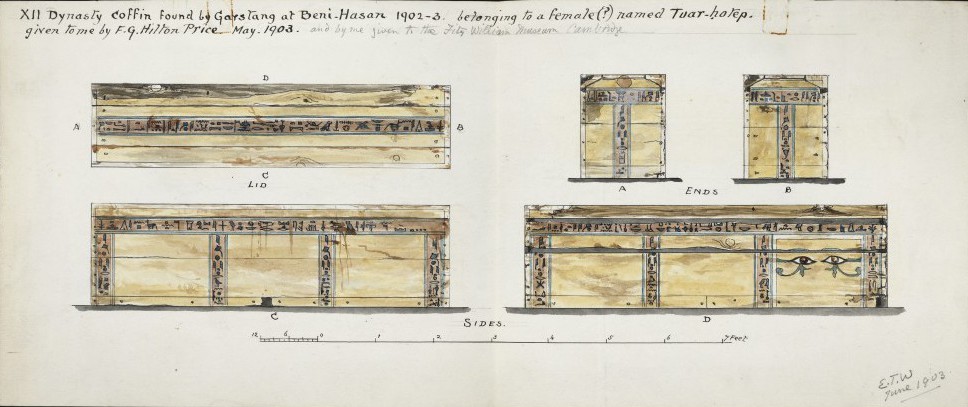
The Instruction of Hardedef is a didactic text written perhaps as early as the 5th Dynasty (2505–2345 BC) – the Pharaonic Period is divided into 30 royal dynasties, themselves grouped into general phases of political unity, such as the Old Kingdom or Middle Kingdom, and of disunity, known as Intermediate Periods. The sage Hardedef advises ancient readers to found a household, and then ‘equip your house in the necropolis.’² To the Egyptians, the tomb was a house for eternity containing the items you wished to use in the afterlife; the coffin was similar to your bed (often, it even came with a headrest – the ancient pillow). To accumulate the objects needed in preparation for death, a noble had to commission them from a workshop; these items could then be stored until needed (as well as updated due to changes in circumstances, such as an increase in status). One such workshop is depicted in the tomb of Ipuy at Thebes, which shows a team of craftsmen putting the finishing touches to tomb equipment, including two coffins.
The industry of death played an important role in Egypt’s economy. Workshops existed across the land, producing coffins and other items according to their own techniques, creating variations in style and quality. Coffin-makers were also employed by embalmers, who ran their own workshops. Even at Deir el-Medina – the state-run village that housed the artisans who cut and decorated the tombs in the Valley of the Kings – the workmen took commissions on the side during quiet periods, producing items for noble burials, such as coffins and furniture, to supplement their state incomes. Consequently, although many museums display their coffins in the ‘burial and afterlife’ section, they can still teach us much about daily life.
Detail from the coffin of Senuitef, showing wedjat eyes, 12th Dynasty, Middle Kingdom, 1975–1790 BC Fitzwilliam Museum, Cambridge
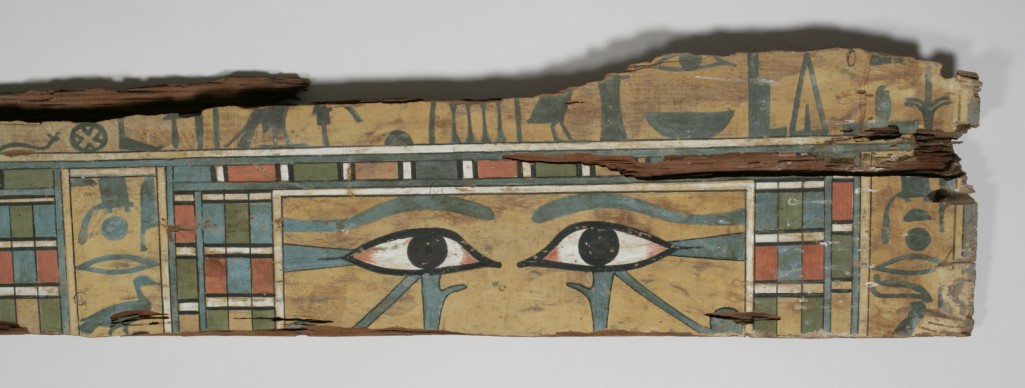
The first Egyptian coffins were produced in around 3500 BC, during the Predynastic Phase of Egyptian history, before a single king ruled the entire country; these took the form of simple uninscribed boxes, with the deceased lying in a contracted position inside. By the late Old Kingdom (2700–2170 BC), however, coffins had become rectangular, allowing the deceased to be stretched out, lying on his or her left side. On the outside of the coffin, artists painted wedjat-eyes, so that the deceased could magically watch the sunrise, an event associated with rebirth. As the Egyptians believed that a part of the individual, known as the ka, remained in the tomb after death, and required offerings – either physical or magical – to survive, religious texts painted on the inner and outer sides of coffins provided the deceased with various kinds of magical nourishment. Completing these offering formulas – as they are known today – was the deceased’s name and titles, which helped the ka to identify the mummified body. These are also helpful to modern scholars interested in reconstructing ancient genealogies. Consequently, coffins provided both physical protection for the body of the deceased, and magical protection and sustenance for the ka.
Coffins also served as status symbols, as it is thought that only 5 per cent of ancient Egyptians could afford to own one. Although cheaper variants could be made from local wood, the highest members of the elite acquired coffins made from quality imported timber. The richest in society could even afford to own a series of nested coffins, each elaborately decorated and varnished, which in turn, were placed within a stone sarcophagus.
The coffin set of Nespawershefyt, 21st Dynasty, Third Intermediate Period, 1070–945 BC Fitzwilliam Museum, Cambridge

Over time, coffin decoration became more complex, with artists increasingly filling the wooden surfaces with texts and decoration. In the Middle Kingdom (2010–1790 BC), spells, known as the Coffin Texts, were painted inside and were believed to help the deceased during his or her journey through the afterlife. At the same time, anthropoid coffins were developed, becoming the dominant form of coffin from the New Kingdom (1550–1070 BC) onwards; made in the shape of a mummified person, these associated the deceased with the god Osiris. After the New Kingdom, coffins, by now often entirely covered with religious scenes and texts, continued to be used until the end of ancient Egyptian civilisation.
With the majority of Egypt’s ancient settlements inaccessible beneath modern towns and villages along the Nile, over recent centuries tourists, antiquarians, and archaeologists have focused their explorations on temples and tombs, built out in the desert or on the edge of the cultivable land, a focus that helped create the myth of Egypt as a place fixated on death. Many were inspired to visit Egypt after the publication of the Description de l’Égypte in the early 19th century, with interest growing with Champollion’s decipherment of hieroglyphics in 1822. They returned home with ‘curiosities’, including fragmentary and whole coffins – objects light enough to be transported to Europe without too much trouble, but impressive enough to gain attention. Excavated in the desert or bought from local vendors, these eventually found their way into museum collections as donations; one Egyptian coffin was bequeathed by William Lethieullier to the British Museum upon his death in 1756, becoming the first object of its kind in the collection, while the mummy and coffins of Asru were donated by William and Robert Garnett to the Manchester Natural History Society in 1825, a collection that later helped form the Manchester Museum. Indeed, coffins were sometimes the first Egyptian antiquities held by a museum, such as the coffins of Nespawershefyt, which were given to the Fitzwilliam Museum, Cambridge in 1822, and started its ancient Egyptian collection.
Wooden face with inlaid eyes, originally part of a coffin, 22nd Dynasty, Third Intermediate Period, 945–735 BC Bagshaw Museum (Kirkless Council), Yorkshire
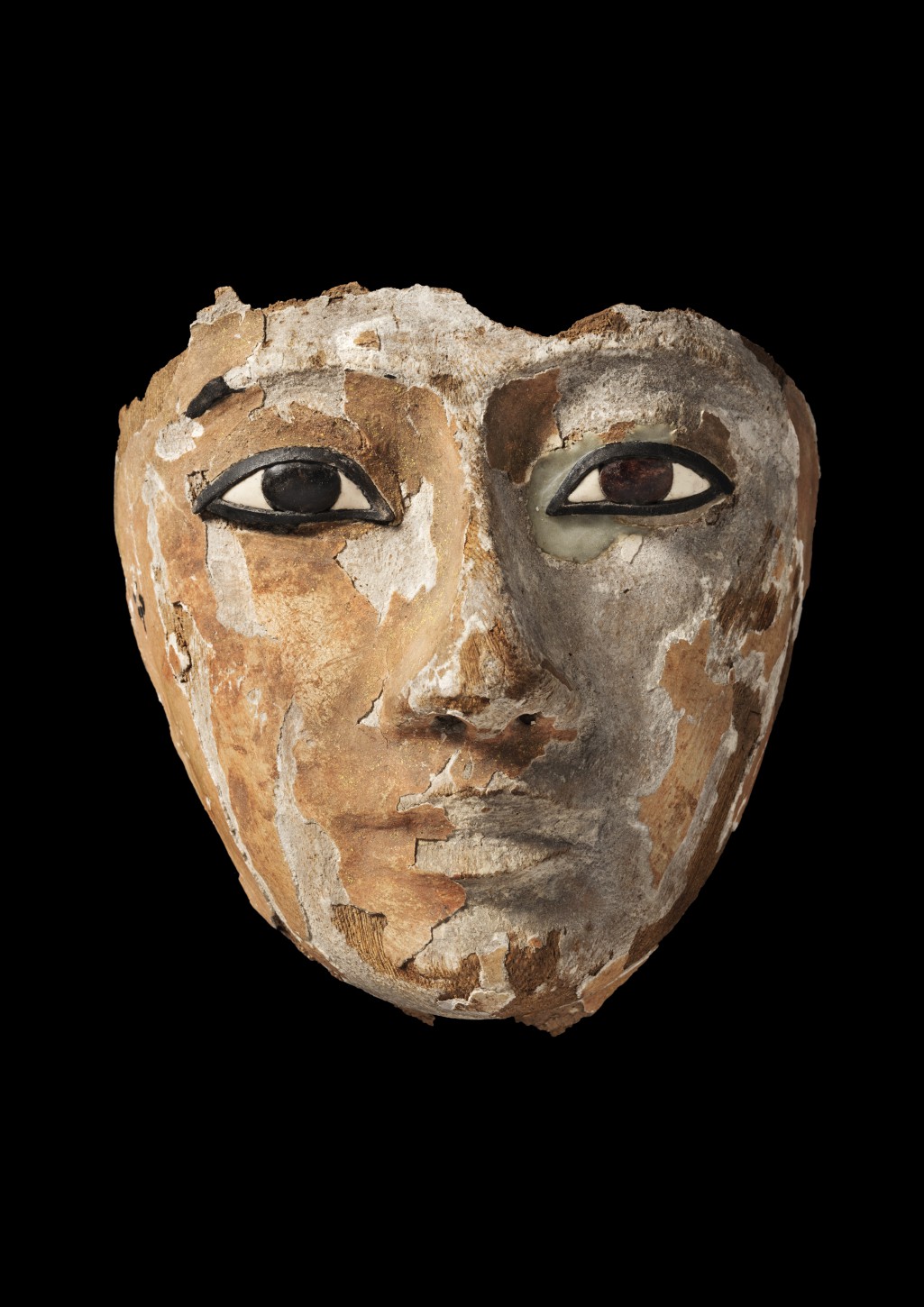
Since then, coffins have been studied extensively by scholars, providing new insights into Egyptian afterlife beliefs, mythology and burial practices. Publications of coffin decoration and religious texts have clarified how their appearance changed over the centuries, the meaning of their art, and the regional variations that existed, enabling coffins without context to be dated with some accuracy and their place of manufacture to be suggested. One extensive study, dedicated entirely to a single coffin – that of Heqata in the Egyptian Museum in Cairo – examined this coffin’s inscriptions in great detail, offering new interpretations of its ritual texts and their purpose, and studying its construction and decoration, showing it to be a type of coffin popular in Egypt’s south during the early Middle Kingdom. More recently, Egyptologists have examined the social significance of coffins, their symbolism, re-use, and the general economy of death. A recent study of an anthropoid coffin in the Museo Civico Archeologico of Bologna used spectroscopic techniques to reveal in detail the materials used in the decoration of the coffin, both in ancient times and in subsequent restoration work, highlighting the importance of modern technologies for the study of ancient artefacts, and opening new possibilities for research.
Despite the vast amount of detail about daily life in ancient Egypt derived from the study of coffins and other items associated with the afterlife, such information is often lacking in museum displays; when faced with a coffin in a gallery, museum-goers expect to learn about death and afterlife beliefs, and with limited space available on labels and panels, it is understandable that additional detail, perhaps regarded as unnecessary in the context, is omitted. Recently, however, a number of special exhibitions have taken the well-trodden themes of death and burial and used them as hooks to present new discoveries. The British Museum’s 2014 blockbuster exhibition ‘Ancient Lives, New Discoveries’ took eight mummies in their collection and used CT-scans to tell visitors their life stories, including details about their diet and health. Similarly, the exhibition ‘Gifts for the Gods: Animal Mummies Revealed’ at Manchester Museum used CT-scans and X-rays to examine beneath the wrappings of animal mummies – another popular topic – to discuss their meaning to the Egyptians, but also how they were bred in huge numbers, and how a third of them actually contained either no animal at all or just assorted bone fragments. Both exhibitions used mummies – perhaps the most popular aspect of ancient Egypt after pyramids – to discuss daily life; they took well-known themes, guaranteed to generate crowds, and put a fresh spin on the material.
Two new exhibitions, opening in early 2016, similarly use objects primarily from burials to inform visitors about daily life in ancient Egypt. At Two Temple Place, London, ‘Beyond Beauty: Transforming the Body in Ancient Egypt’ gathers artefacts from seven museums across the UK to examine the importance of appearance to the ancient Egyptians, and demonstrates the significance of the body, both in life and death, as well as changing styles over time. The wooden face of a coffin from the Third Intermediate Period stares out with inlaid eyes; a fragment from a mummy board shows the god Anubis standing in front of a man; a brightly painted coffin fragment presents a woman in a flowing white dress; while a carved wooden fragment depicts a winged goddess, her arms and wings outstretched. One of the complete coffins on display is the cartonnage mummy case for the chantress Shebmut, dated to between 945–715 BC; it is representative of the careful and meticulous work that the artisans put into such items, particularly in the painting of hieroglyphs and deities. By emphasising the concept of beauty, the exhibition has partly removed the objects from the sphere of death, asking viewers to engage with them again in a different manner; these ancient artefacts represent living people, who were as concerned with their appearance as anyone alive today. They are far more than simply tomb furnishings associated with death.
Fragment of a mummy board, 19th Dynasty, New Kingdom, 1290–1185 BC Royal Pavilion & Museums, Brighton and Hove
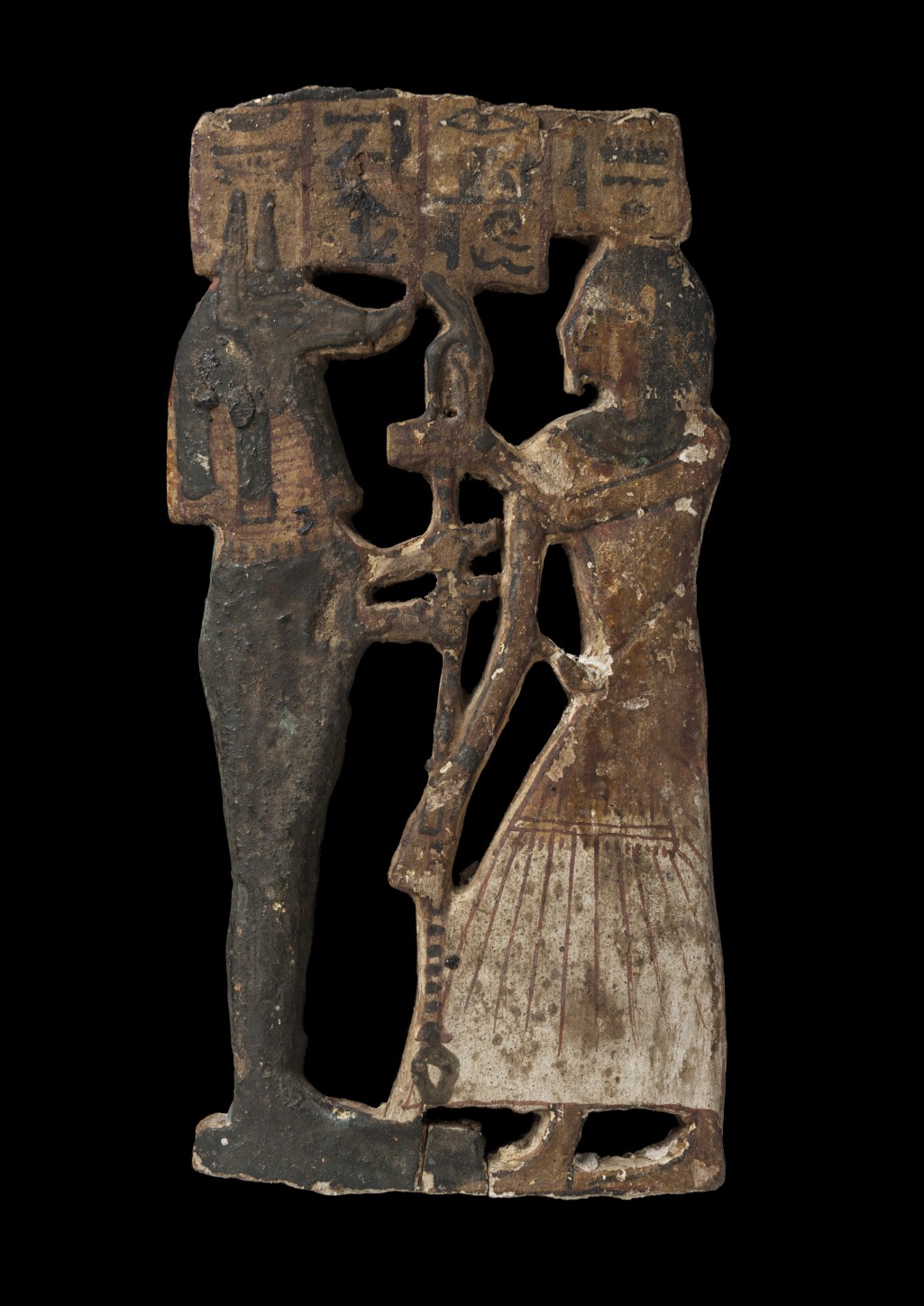
As with ‘Beyond Beauty’, coffins, both fragmentary and complete, figure prominently in ‘Death on the Nile: Uncovering the Afterlife of Ancient Egypt’ at the Fitzwilliam Museum, Cambridge; as well as a discussion of afterlife beliefs, the exhibition has used the results of CT-scans and X-rays to examine the lives of the artisans who created the coffins, their skills in constructing them, and the nobles by whom they were commissioned, rather than just the bodies within the mummy wrappings and the skill of the embalmers. In this manner, the exhibitions blur the traditional separation between objects of daily life and the afterlife. Through close study and the novel use of modern technologies, it is revealed that the coffin of Userhet, dated to the late 12th Dynasty (1975–1790 BC), split during manufacture, and was repaired by artisans who sewed it shut and filled it with paste. Drops of blue paint on the coffin of Khety freeze in time the moment that he left his brush to drip during painting. One of the coffins of Nespawershefyt, from around 1000 BC, had been repaired in ancient times, and his titles repainted to reflect his developing career; as a result, we can assume that Nespawershefyt commissioned his coffin well before his death, and kept it with him for much of his life. His inner coffin also bears the handprint of one of the artisans, left in the varnish, from when the coffin was being carried. Through these objects, we can see artisans at work, nobles concerned about their status and the life behind the industry of death.
Both exhibitions, and those at the British Museum and Manchester Museum before them, represent the increasing movement of curators taking what could be viewed as clichés of Egyptology – coffins, canopic jars, mummies – and adding a technological spin or a novel change of viewpoint. By doing so, the expectations of museum-goers for a mysterious, death-obsessed Egypt are met, but they are also presented with new insights based on modern research that might otherwise not find a place in the permanent galleries. Using death, they shine a spotlight on the reality of life in ancient Egypt.
‘Beyond Beauty: Transforming the Body in Ancient Egypt’ is at Two Temple Place, London, until 24 April; ‘Death on the Nile: Uncovering the Afterlife of Ancient Egypt‘ is at the Fitzwilliam Museum, Cambridge, from 23 February–22 May.
